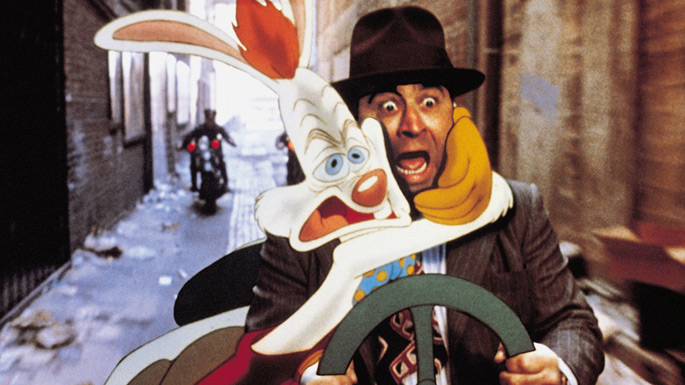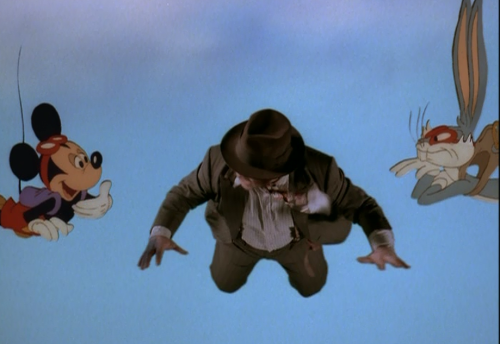How was “Who Framed Roger Rabbit” made?
Quick Answer: Who Framed Roger Rabbit was innovative for the way that it convincingly combined the real world and cartoon characters. This effect was achieved by shooting all of the live-action sequences and then going back in to hand-draw the animation. However, it wasn’t just the animators who were responsible for this critical and commercial success. Convincingly creating this half-Toon, half-human spectacle was a labor of love on the part of the actors, the art department, the props department, special effects, and those who handled the legal red tape.
Based on the 1981 mystery novel Who Censored Roger Rabbit?, Who Framed Roger Rabbit (1988) takes place in a world where cartoons and human beings live side by side, if not always in peace. With its noir murder-mystery plot and abundance of cartoon characters, the film seemed to float somewhere in between adult and child audiences, too childish for the former and too risqué for the latter. So who exactly was the movie for?

Roger Rabbit, Voiced by Charles Fleischer, and Bob Haskins in Who Framed Roger Rabbit (1988)
As it turns out, everybody. The film grossed $154,112,492 domestically and made $351,500,000 worldwide. It was a commercial success and a critical one, too, taking home three Academy Awards (Best Sound Editing, Best Visual Effects, and Best Film Editing) with four additional nominations. Richard Williams, the film’s animation director, won a Special Achievement Academy Award for his work. And now, 28 years later, the film has still maintained its cult status.
Part of the enduring appeal of the movie is the impressive production feat. In the film, the Toons are constantly interacting with humans and their physical environments. Even when Toons are in the human world (or rather, in the film’s setting of 1940s Hollywood), they maintain what makes them so loony. They exhibitive certain elements of human physicality - for example, they cast shadows and feel the pull of gravity - but they also have uniquely cartoon qualities, such as the birds that circle around them when they get hit in the head. Perhaps most impressive is that this was in the days before CGI. That means the entire film had to be shot first and the animation drawn in by hand after. This process also required meticulous work on the part of the actors, who had to convincingly interact with thin air. (Charles Fleischer, the voice of Roger, even requested a bunny suit be made for him to act in on set.) The art and props departments had their work cut out for them, as well; the teams had to painstakingly manufacture the Toons’ physical impact on the real world.

Bob Haskins and Jessica Rabbit, Voiced by Kathleen Turner
Disney executives were skeptical of all the heavy lifting the film would require. That’s why the team put together a short test scene involving the two main characters, human Eddie Valiant (Bob Haskins) and his cartoon companion, the eponymous Roger Rabbit, just to prove to the production studio that their vision was possible. The test scene, like the film, was a huge hit.
But production technicalities weren’t the team’s only worries. There was a great deal of legal red tape to navigate in order to include so many classic cartoon characters in the film. The film saw cameos from Bugs Bunny, Mickey Mouse, Minnie Mouse, Donald Duck, Daffy Duck, Betty Boop, Tweety, Woody Woodpecker, Yosemite Sam, Pinocchio and Porky Pig, just to name a few. For those familiar with today’s competing studios’ distinct universes populated by the superhero characters each owns, it may seem surprising that anyone ever managed to get all these characters (legally) into one movie. Indeed, Who Framed Roger Rabbit was the first and only time that Walt Disney and Warner Brothers cartoon characters shared the big screen.

Mickey Mouse, Bugs Bunny and Bob Haskins in Who Framed Roger Rabbit
Even without any knowledge of the behind-the-scenes nuts and bolts, it’s easy to appreciate the film’s originality and deftness in how matter-of-factly it presents the lives of Toons and how cleverly it integrates their presence into the universe of the film. The Toons work as actors in – you guessed it – cartoons. They drink, they get married, they get into fights. They get on humans’ nerves. They might even commit murder.
Because it integrated these adult-behaving Toons into a rough-and-tumble society, the movie is less kid-friendly than you would expect for a film starring a talking rabbit. With its violence and sexual humor, it’s unlikely that Who Framed Roger Rabbit would have the same PG rating if it had been made today. Considering how over-time, over-budget and downright risky the production was, we’re lucky it was made at all.

